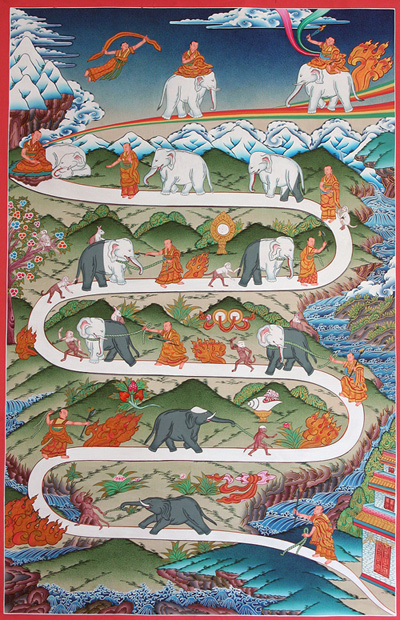Meditation – The Pathway To Spirituality
Virtually all spiritual traditions, religions and self-improvement programmes emphasise the importance of meditation as part of ones spiritual practice. Theosophy emphasises a threefold approach to spiritual evolvement – so we may come to know who we really are. This approach is echoed in many the Sacred Texts. They are Study, Meditation and Service.
 Meditation is the key to assimilating what we study and an essential method to unravel the complex layers of our consciousness to discover our true nature.
Meditation is the key to assimilating what we study and an essential method to unravel the complex layers of our consciousness to discover our true nature.
Meditation is the inexpressible longing of the inner man for the Infinite. – HP Blavatsky
Some of the Aims of Meditation are:
- To experience peace, serenity and harmony
- To transcend the mind and enter into a state of pure Being
- To experience the nature of the Self
- To discover the nature of existence and distinguish the Real from the Unreal
- To experience the Universal concept of God or Universal Spirit
The Basic Purpose of Meditation
The object of Meditation is to achieve identification of the personality with the ego, and later of the ego with the monad and finally to obtain union with God. – G. Hodson
Through the practice of meditation we begin to experience degrees of understanding. Under normal circumstances it brings a calming and peacefulness to our nature. With continued practice we come to realise our connection with nature, with the world around us. We begin to open up to a wider reality as our consciousness or awareness expands to a far greater reality. We come to experiences moments of love and bliss, which expand with our practice.
Meditation consists in the endeavour to bring into the waking consciousness, that is into the mind in its normal state of activity, some realisation of the superconscious. – Bishop Wedgewood
Concentration
Nowhere does it say anything else but this: if you hope to develop Insight (vipashyana: comprehension), the training of wisdom, you must find Quietude (shamatha / dhyana), that of concentration. – Tsong Khapa
Concentration practice (shamatha) is the basis from which we can retrieve information (insight / vipashyana / comprehension). Therefore, concentration practice is the ground from which the flower of meditation emerges. However, concentration practice itself is not meditation. Meditation begins once concentration has been established. Actual meditation is defined as a state of consciousness within which we can retrieve information.
 Prerequisites
Prerequisites
To make real progress in mediation it is important to develop the prerequisites of good concentration. Therefore, it is very wise to pay close attention to these prerequisites, no matter how long we have been studying or practicing.
- Conducive place: In general, this concerns the environment we live in.? The place of practice must be one where can can relax completely without undue disturbance. A place that is untidy or has been used for harmful or violent purposes creates a negative atmosphere. A home filled with dissension will not be peaceful. If possible, we should do our best to establish ourselves in a peaceful, clean, safe environment.
- Cultivating few desires: Too many desires keep the mind agitated and unhappy. The simpler we can live, the fewer desires we have, the more peaceful we will be.
- Being content: The less we own and are responsible for, the less there is to trouble the mind. Being content with what we have instils peace. Discontentment agitates the mind.
- Reducing social engagement: Engaging in a lot of worldly activities keeps the mind agitated. The more we can simplify our life, the more stable the mind will be.
- Pure ethics: Harmful activities greatly disturb the mind. In order to learn how to meditate, such activities must be completely stopped. Harmful activities include any actions (even in the heart and mind) which cause harm to ourselves or to others. Examples include ingesting intoxicants, lying, stealing, killing, and more. All of these actions create karma and negatively impact the mind.
- Abandoning conceptual thought: Intellectualizing the teachings will distract us and impede our practice. Fantasy must cease in order for intuition to function.? Thus, daydreaming, conceptualizing, and any form of mechanical imagination must be stopped.
The prerequisites are critical for effective development of our practice. Each one requires continual effort. Self-observation is the very foundation of developing concentration:
- Self-observation is how we discover the activities, thoughts and feelings that impede our concentration practice.
- Self-observation is an activity of directed attention, thus it is the very same activity that we are trying to develop in our concentration practice; the more we self-observe, the stronger our concentration becomes.
The Object of Concentration
In order to develop concentration, the practitioner adopts an object of meditation. Traditional objects include the breath, sacred images, or sacred sounds. The sooner a student learns how to concentrate and consciously direct both attention and imagination, the sooner they will understand and access Samadhi (ecstasy), the doorway to comprehension.
 Illustration of the Nine States
Illustration of the Nine States
The following image is common to all the schools of Tibetan Buddhism, and represents the teaching of Buddha Maitreya. Images like this one have traditionally been painted as murals on the walls of monasteries and places of instruction.

Nine States of concentration
For more information in the Nine Mental States of Concentration then have a look at this website: http://gnosticteachings.org
Meditation consists in preparing the personal nature, so that it is able to reflect and express its relationship with the Universal Self? – A Gardner
Comments (0)